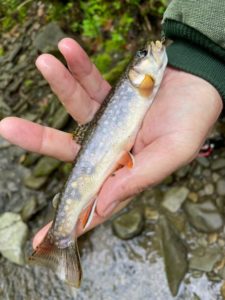
By Jeff Woleslagle
 As water temperatures warm across the state, for most fish species that means it is time to spawn. In the spring, spawning is staggered by species and depends heavily on water temperatures. Northern pike are known to spawn in very cold water shortly after ice out. Following that, bass migrate toward the banks for their mating ritual and then later still, bluegills and other sunfish begin creating dish-shaped beds near the shore. Largemouth bass prefer water temperatures between 60-75 degrees for spawning, while bluegills spawn when water temperatures are in the 75–85-degree range. This staggering reduces competition for nest sites and both species will act as predators on each other’s eggs and fry.
As water temperatures warm across the state, for most fish species that means it is time to spawn. In the spring, spawning is staggered by species and depends heavily on water temperatures. Northern pike are known to spawn in very cold water shortly after ice out. Following that, bass migrate toward the banks for their mating ritual and then later still, bluegills and other sunfish begin creating dish-shaped beds near the shore. Largemouth bass prefer water temperatures between 60-75 degrees for spawning, while bluegills spawn when water temperatures are in the 75–85-degree range. This staggering reduces competition for nest sites and both species will act as predators on each other’s eggs and fry.
While most male mammals are larger than their female counterparts, females of most freshwater fish species grow to larger average sizes than males. Differences between the sexes are most apparent near spawning time, when the females lay their eggs and males fertilize and often guard the nests, which is usually in the spring or early summer.
 Interestingly though, not all of Pennsylvania’s fish spawn in the springtime. Here in the pristine headwater streams of our forests, both the native brook trout and the wild brown trout breed in the fall. Brook trout, our state fish, develop rapidly and normally mature in two years. In fact, some will spawn after just one year. Spawning occurs between September and October and fry emerge sometime between February and April. Young brook trout typically look for shelter in submerged aquatic vegetation or shallow water near the shoreline. They will consume zooplankton and tiny insects until they grow large enough to venture out deeper and start eating bigger prey items. Unlike their salmon relatives, brook and brown trout do not die after mating and can successfully spawn year after year.
Interestingly though, not all of Pennsylvania’s fish spawn in the springtime. Here in the pristine headwater streams of our forests, both the native brook trout and the wild brown trout breed in the fall. Brook trout, our state fish, develop rapidly and normally mature in two years. In fact, some will spawn after just one year. Spawning occurs between September and October and fry emerge sometime between February and April. Young brook trout typically look for shelter in submerged aquatic vegetation or shallow water near the shoreline. They will consume zooplankton and tiny insects until they grow large enough to venture out deeper and start eating bigger prey items. Unlike their salmon relatives, brook and brown trout do not die after mating and can successfully spawn year after year.
When you venture along the water this spring and summer, you may notice fish spawning, but know that for some of our fish, it is an activity that may be delayed until fall or even years later.
Forest Fridays is a feature of the DCNR Bureau of Forestry.




